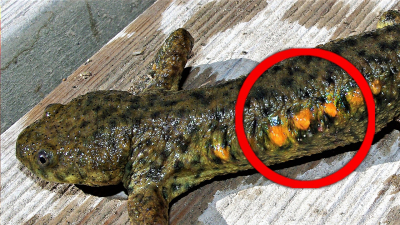
Our planet is indeed a wonderland with zillions of creatures inhabiting it, each having its own unique way of adapting to its habitat. Among these, there are some creatures that have developed some bizarre defence mechanisms. Let’s read up on some of these animal species.
IBERIAN RIBBED NEWT
Imagine ribs that you can use as poisonous spikes. The iberian ribbed newt is capable of pushing its ribs outside its skin when attacked. These form spikes which the newt uses to defend itself. The animal does this by moving its ribs away from the spine and increasing their angle by 50 degrees. The tips of the ribs then stick outside the animal’s body, like a set of spines. At the same time, the newt is capable of producing a poisonous milky substance on its body surface. This coupled with its protruding ribs acts as its stinging tool.
GOLDEN POISON FROG
The golden poison frog is one of the most toxic animals on Earth. It is known for its vibrant colours and the potent poison produced by its skin. While its bright colour is itself a warning sign to predators, the frog takes its defence one notch higher by producing toxins such as steroidal alkaloids batrachotoxin, homobatrachotoxin, and batrachotoxin A. These compounds can cause arrhythmias, fibrillation, and cardiac failure in humans.
TEXAS HORNED LIZARD
Here is a lizard that shoots blood from its eyes. When under threat, the Texas horned lizard sprays out pressurised blood from the corners of its eyes at its attacker. In biology, this is called autohaemorrhaging or reflex bleeding. The animal resorts to this when all its other defences such as camouflage fail. This is carried out by the lizard by rupturing its own sinus membranes.
MOTYXIA MILLIPEDE
While the most common defence mechanism is to display vibrant colours to ward off predators, there are some animals that use their bioluminescence as a warning. A genus of millipedes that is endemic to California called the Motyxia uses its bioluminescence to warn off predators. But the most unusual ability this creature possesses is that it can produce and ooze cyanide from the pores on its body. The cyanide is toxic for the predators of this species such as rodents, centipedes, and beetles.
MALAYSIAN ANT
Imagine a defence strategy that kills your predator but you end up getting the raw deal as well. These are the ants that will destroy themselves to defend their colony when under attack. These exploding ants are called the Malaysian ants. Whenever their nest is invaded, they will “blow” up (rupture) their abdomens. The ants have poison glands that get burst when they flex their body, releasing the poisonous substance onto their predator. This can either kill the enemy or incapacitate it.
HAIRY FROG
Meet the “Wolverine” in the wild. When threatened, this frog can crack its own finger bones and pierce them through its skin. These are then used as claws. On one end of the bone, there is a muscle that the frog can use to contract and thereby break a fragment of bone and push it outwards.
Picture Credit : Google




